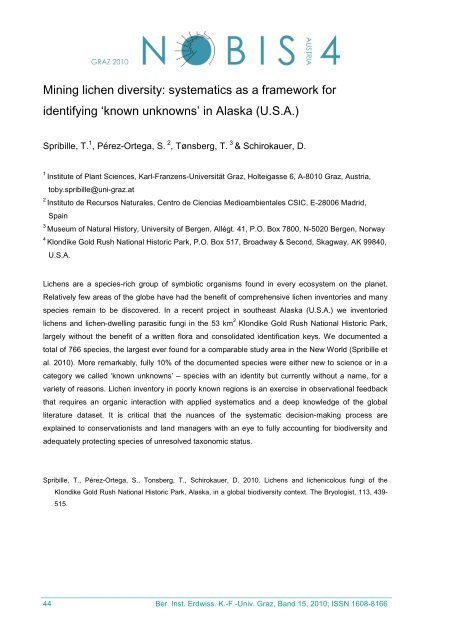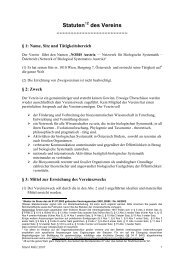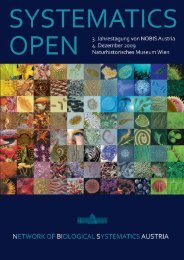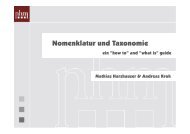4. Jahrestagung von NOBIS Austria 2. - 3. Dezember 2010
4. Jahrestagung von NOBIS Austria 2. - 3. Dezember 2010
4. Jahrestagung von NOBIS Austria 2. - 3. Dezember 2010
You also want an ePaper? Increase the reach of your titles
YUMPU automatically turns print PDFs into web optimized ePapers that Google loves.
Mining lichen diversity: systematics as a framework for<br />
identifying ‘known unknowns’ in Alaska (U.S.A.)<br />
Spribille, T. 1 , Pérez-Ortega, S. 2 , Tønsberg, T. 3 & Schirokauer, D.<br />
1 Institute of Plant Sciences, Karl-Franzens-Universität Graz, Holteigasse 6, A-8010 Graz, <strong>Austria</strong>,<br />
toby.spribille@uni-graz.at<br />
2 Instituto de Recursos Naturales, Centro de Ciencias Medioambientales CSIC, E-28006 Madrid,<br />
Spain<br />
3 Museum of Natural History, University of Bergen, Allégt. 41, P.O. Box 7800, N-5020 Bergen, Norway<br />
4 Klondike Gold Rush National Historic Park, P.O. Box 517, Broadway & Second, Skagway, AK 99840,<br />
U.S.A.<br />
Lichens are a species-rich group of symbiotic organisms found in every ecosystem on the planet.<br />
Relatively few areas of the globe have had the benefit of comprehensive lichen inventories and many<br />
species remain to be discovered. In a recent project in southeast Alaska (U.S.A.) we inventoried<br />
lichens and lichen-dwelling parasitic fungi in the 53 km 2 Klondike Gold Rush National Historic Park,<br />
largely without the benefit of a written flora and consolidated identification keys. We documented a<br />
total of 766 species, the largest ever found for a comparable study area in the New World (Spribille et<br />
al. <strong>2010</strong>). More remarkably, fully 10% of the documented species were either new to science or in a<br />
category we called ‘known unknowns’ – species with an identity but currently without a name, for a<br />
variety of reasons. Lichen inventory in poorly known regions is an exercise in observational feedback<br />
that requires an organic interaction with applied systematics and a deep knowledge of the global<br />
literature dataset. It is critical that the nuances of the systematic decision-making process are<br />
explained to conservationists and land managers with an eye to fully accounting for biodiversity and<br />
adequately protecting species of unresolved taxonomic status.<br />
Spribille, T., Pérez-Ortega, S., Tonsberg, T., Schirokauer, D. <strong>2010</strong>. Lichens and lichenicolous fungi of the<br />
Klondike Gold Rush National Historic Park, Alaska, in a global biodiversity context. The Bryologist, 113, 439-<br />
515.<br />
_____________________________________________________________________________<br />
44 Ber. Inst. Erdwiss. K.-F.-Univ. Graz, Band 15, <strong>2010</strong>; ISSN 1608-8166






